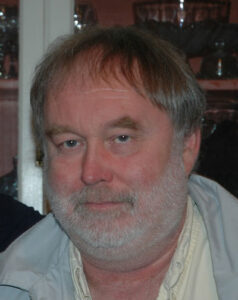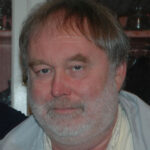A Memory from Rick
 I met Ken back in 1976 I believe when Rader hired him to work in the corporate group where I had been working for a couple years after graduating from OSU with an engineering degree. Ken was asked to work with me to integrate the Thompson Dehydrating Company, (TDC), dryer technology into Rader. My focus of study had included power plants including combustion, steam generation and electrical power generation. Ken with his physics background made not only a good partner for that task but ended up being a lifelong friend and colleague. There are so many experiences we had together that it is hard for me to think of one that is not dwarfed by the others.
I met Ken back in 1976 I believe when Rader hired him to work in the corporate group where I had been working for a couple years after graduating from OSU with an engineering degree. Ken was asked to work with me to integrate the Thompson Dehydrating Company, (TDC), dryer technology into Rader. My focus of study had included power plants including combustion, steam generation and electrical power generation. Ken with his physics background made not only a good partner for that task but ended up being a lifelong friend and colleague. There are so many experiences we had together that it is hard for me to think of one that is not dwarfed by the others.
I remember for example he and I standing in front of a chalk board writing equations to understand drying application, gas properties, combustion and heat transfer, arguing about what was really going on in the physical drying system. We had to understand it better than anyone or we would not be able to move the technology forward. The engineer from TDC would visit the Portland Oregon offices and spend time with Ken and I teaching us how he did the dryer sizing which was a combination of some calculations and rules of thumb. I studied his methods to understand what he did and Ken went off and developed his own equations eventually generating a quattro pro spreadsheet that became the basis of all our future dryer process design. I subsequently generated a separate method so that we could test against each other’s work and compare to the TDC method. He and I did extensive testing and refinement over the next few years taking field measurements and using our calculations to model what we measured and make sure our methods were accurate.
We went from wondering if our calculations and applications would work to later in years knowing we were going to be successful. He and I used to be on start up trips at various plants were we would participate in the check out, start up and training of operators. Ken would say to me that he expected us to be two old guys cruising around in wheelchairs doing the same job until we just stopped functioning. In the early days it was not always automatic that the system would perform to contract and there were some reworks required but we always got the equipment to perform. Ken would say if he won the lottery and got one million dollars, he would keep doing dryers until it was all gone. Thankfully, we improved in both the application accuracy and the machinery design so that dryers became a profitable business.
By then Rader had been sold because the parent company went bankrupt, Ken and I had gone on to different companies and consulting, but we always stayed connected and worked together on drying systems. At tsi, we started with a clean sheet of paper designing a new generation of dryers that were mechanically improved. We created even better methods of modeling different manufacturing processes adapting new heat sources, modeling more complex gas mixing schemes and tsi became a world leader in drying technology. There were many times when tsi was too busy to handle all the field start up and training that sometimes happened one on top of the other. Ken would jump on a plane and go help train operators, trouble shoot system issues or whatever was needed.
There were many times he and I were on job sites facing frustrating circumstances with difficult people, but Ken would always come up with something that made me laugh about our situation. I will miss my friend and colleague.
Rick
 I met Ken back in 1976 I believe when Rader hired him to work in the corporate group where I had been working for a couple years after graduating from OSU with an engineering degree. Ken was asked to work with me to integrate the Thompson Dehydrating Company, (TDC), dryer technology into Rader. My focus of study had included power plants including combustion, steam generation and electrical power generation. Ken with his physics background made not only a good partner for that task but ended up being a lifelong friend and colleague. There are so many experiences we had together that it is hard for me to think of one that is not dwarfed by the others.
I met Ken back in 1976 I believe when Rader hired him to work in the corporate group where I had been working for a couple years after graduating from OSU with an engineering degree. Ken was asked to work with me to integrate the Thompson Dehydrating Company, (TDC), dryer technology into Rader. My focus of study had included power plants including combustion, steam generation and electrical power generation. Ken with his physics background made not only a good partner for that task but ended up being a lifelong friend and colleague. There are so many experiences we had together that it is hard for me to think of one that is not dwarfed by the others.
I remember for example he and I standing in front of a chalk board writing equations to understand drying application, gas properties, combustion and heat transfer, arguing about what was really going on in the physical drying system. We had to understand it better than anyone or we would not be able to move the technology forward. The engineer from TDC would visit the Portland Oregon offices and spend time with Ken and I teaching us how he did the dryer sizing which was a combination of some calculations and rules of thumb. I studied his methods to understand what he did and Ken went off and developed his own equations eventually generating a quattro pro spreadsheet that became the basis of all our future dryer process design. I subsequently generated a separate method so that we could test against each other’s work and compare to the TDC method. He and I did extensive testing and refinement over the next few years taking field measurements and using our calculations to model what we measured and make sure our methods were accurate.
We went from wondering if our calculations and applications would work to later in years knowing we were going to be successful. He and I used to be on start up trips at various plants were we would participate in the check out, start up and training of operators. Ken would say to me that he expected us to be two old guys cruising around in wheelchairs doing the same job until we just stopped functioning. In the early days it was not always automatic that the system would perform to contract and there were some reworks required but we always got the equipment to perform. Ken would say if he won the lottery and got one million dollars, he would keep doing dryers until it was all gone. Thankfully, we improved in both the application accuracy and the machinery design so that dryers became a profitable business.
By then Rader had been sold because the parent company went bankrupt, Ken and I had gone on to different companies and consulting, but we always stayed connected and worked together on drying systems. At tsi, we started with a clean sheet of paper designing a new generation of dryers that were mechanically improved. We created even better methods of modeling different manufacturing processes adapting new heat sources, modeling more complex gas mixing schemes and tsi became a world leader in drying technology. There were many times when tsi was too busy to handle all the field start up and training that sometimes happened one on top of the other. Ken would jump on a plane and go help train operators, trouble shoot system issues or whatever was needed.
There were many times he and I were on job sites facing frustrating circumstances with difficult people, but Ken would always come up with something that made me laugh about our situation. I will miss my friend and collogue.
Rick